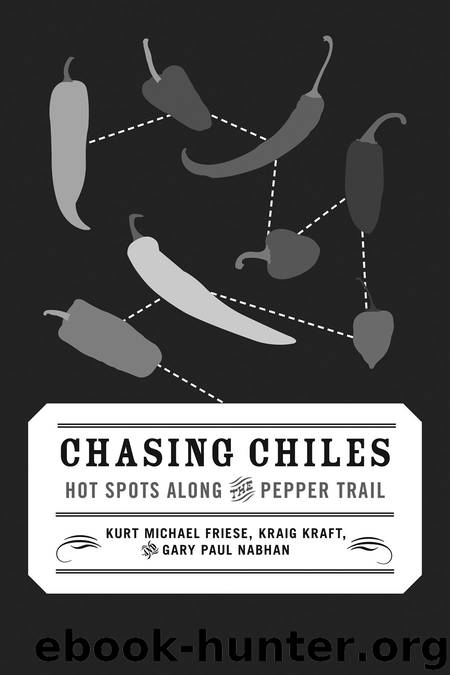Chasing Chiles by Kurt Michael Friese Kraig Kraft & Gary Paul Nabhan

Author:Kurt Michael Friese, Kraig Kraft & Gary Paul Nabhan
Language: eng
Format: epub
Publisher: Chelsea Green Publishing
Published: 2011-11-06T16:00:00+00:00
You’ve probably heard of capsaicin before: It’s the main culprit among an entire class of molecules that are the reason for the pain and pleasure in chile peppers, and probably the sole reason why humans began to domesticate chile peppers in the first place, some seven thousand years ago. There are nine different capsaicinoids that trigger a physiological response. The most important of these nine is capsaicin, which makes up about 70 percent of all capsaicinoids found in your average chile pepper. Capsaicinoids are hydrophobic molecules, meaning they don’t like water and will not dissolve in pure water. Which should put to rest the common perception that to quench your pepper-scorched mouth you should drink cold water. On the contrary, you need something with some oil or fat to wash it away—try milk, yogurt, or ice cream.
Capsaicin triggers a physiological response in all mammals. In humans, the body reacts to capsaicin as it reacts to elevated temperatures—in fact, areas of the body in direct contact with it experience a burning sensation. In small doses, capsaicin increases mucus secretion in the lungs and nose and causes a release of endorphins, creating an effect similar to the runner’s high, which can be an addictive feeling—hence the comparisons to substance dependency with chileheads, who just have to have a little heat in everything they eat.
Evolutionarily speaking, capsaicin is a plant defense mechanism that evolved over time. What makes this a great tool is that birds do not have the same ability to “taste” this heat, and seeds pass right through their gut. This allows the birds to consume chile fruits and later disperse the seeds through their excrement, while at the same time deterring rodents and other mammals that might damage or destroy the seeds while consuming them or the fruits. Recently, it has also been noted that wild populations of a pepper with a genetic mutation that makes them non-pungent are more likely to experience fungal infections in the seeds, effectively killing them. Whether fungi or mammals, capsaicin will burn anything in defense of the seeds—something to keep in mind the next time you seek a chile fix.
Kraig
Download
This site does not store any files on its server. We only index and link to content provided by other sites. Please contact the content providers to delete copyright contents if any and email us, we'll remove relevant links or contents immediately.
A Court of Wings and Ruin by Sarah J. Maas(7257)
The Sprouting Book by Ann Wigmore(3409)
Better Homes and Gardens New Cookbook by Better Homes & Gardens(3371)
The Death of the Heart by Elizabeth Bowen(3340)
BraveTart by Stella Parks(3305)
Salt, Fat, Acid, Heat: Mastering the Elements of Good Cooking by Nosrat Samin(2997)
Sauces by James Peterson(2961)
The Bread Bible by Rose Levy Beranbaum(2885)
Classic by Mary Berry(2833)
Kitchen confidential by Anthony Bourdain(2826)
Solo Food by Janneke Vreugdenhil(2821)
Ottolenghi - The Cookbook by Yotam Ottolenghi(2736)
Martha Stewart's Baking Handbook by Martha Stewart(2673)
Betty Crocker's Good and Easy Cook Book by Betty Crocker(2597)
Day by Elie Wiesel(2592)
My Pantry by Alice Waters(2431)
The Plant Paradox by Dr. Steven R. Gundry M.D(2425)
The Kitchen Counter Cooking School by Kathleen Flinn(2393)
Hot Sauce Nation by Denver Nicks(2369)
